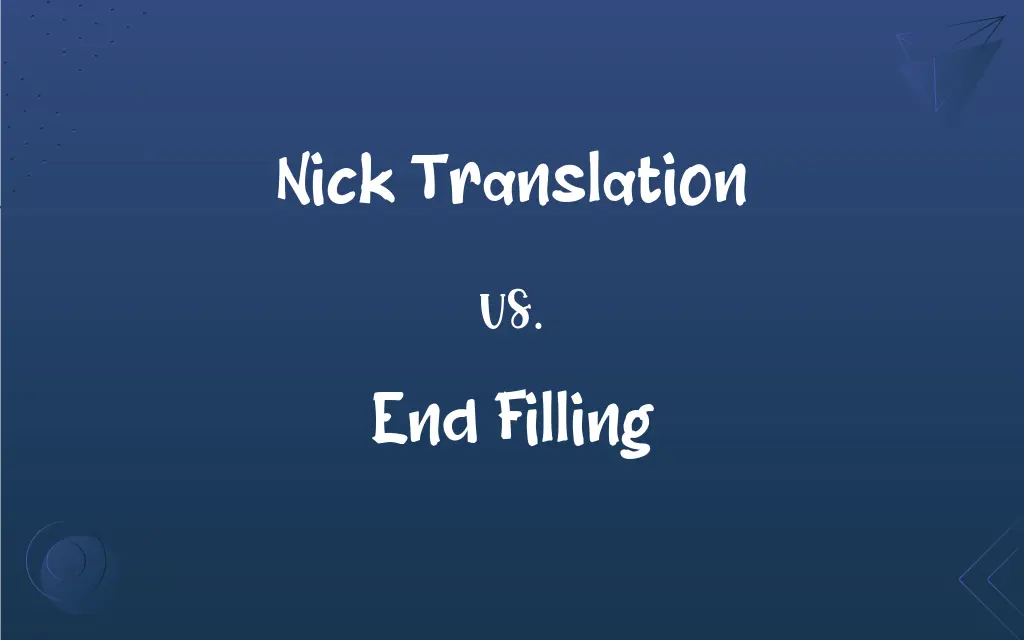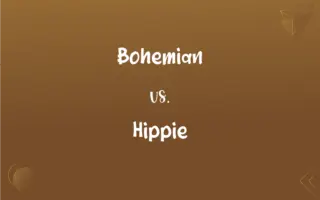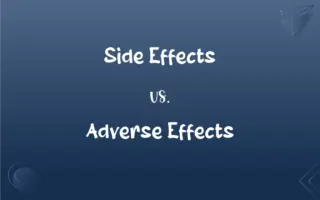Nick Translation vs. End Filling: What's the Difference?
Edited by Aimie Carlson || By Harlon Moss || Published on February 1, 2024
Nick translation involves modifying DNA by creating nicks and adding nucleotides, while end filling is the process of adding nucleotides to blunt DNA ends.

Key Differences
Nick translation is a DNA labeling technique where nicks are introduced into the DNA strand, followed by the addition of nucleotides using DNA polymerase. In contrast, end filling involves adding nucleotides to the ends of DNA fragments, typically to create blunt ends.
During nick translation, DNA polymerase and DNase I enzymes work together; DNase I creates nicks and DNA polymerase fills these with new nucleotides. End filling, however, predominantly relies on DNA polymerase to add nucleotides to sticky or overhanging ends of DNA fragments.
Nick translation is commonly used for DNA labeling, especially in fluorescence in situ hybridization (FISH). End filling finds its application in cloning, where it facilitates the insertion of DNA fragments into vectors.
Nick translation involves simultaneous degradation and synthesis of DNA strands. End filling, on the other hand, only involves the synthesis part, where nucleotides are added to make the ends of DNA fragments compatible for further reactions.
The outcome of nick translation is a labeled DNA strand useful for detection and hybridization studies. End filling results in blunt-ended DNA fragments suitable for cloning into vectors without overhangs.
ADVERTISEMENT
Comparison Chart
Primary Purpose
DNA labeling for detection and hybridization
Preparing DNA ends for cloning
Enzymatic Requirement
DNase I and DNA polymerase
DNA polymerase
Process Action
Creation of nicks and nucleotide addition
Addition of nucleotides to DNA ends
Common Application
Fluorescence in situ hybridization (FISH)
DNA cloning
Resulting DNA Structure
Labeled DNA strands
Blunt-ended or smoothed DNA fragments
ADVERTISEMENT
Nick Translation and End Filling Definitions
Nick Translation
DNA Labeling Technique.
Used in FISH to label DNA probes.
End Filling
Blunt End Creation.
Converts sticky ends to blunt ends in DNA.
Nick Translation
Utilizes DNase I and Polymerase.
Employs enzymes for nick creation and filling.
End Filling
DNA End Modification.
Prepares DNA fragments for cloning.
Nick Translation
Combines Degradation and Synthesis.
Creates and fills nicks in DNA strands.
End Filling
Facilitates Cloning Process.
Ensures compatibility with cloning vectors.
Nick Translation
Suitable for Detection Studies.
Helps in locating specific DNA sequences.
End Filling
Uses DNA Polymerase.
Enzyme adds nucleotides to DNA ends.
Nick Translation
Involves Nucleotide Addition.
Adds labeled nucleotides for visualization.
End Filling
Smooths Overhanging Ends.
Makes uneven DNA ends uniform.
FAQs
What is nick translation?
A method to label DNA by creating and filling nicks.
Is nick translation specific?
It targets specific DNA sequences.
What is end filling?
A process to add nucleotides to DNA ends.
Does end filling work on all DNA ends?
It works best on overhanging ends.
Why is end filling important?
It prepares DNA for cloning.
What enzyme is used in end filling?
DNA polymerase is typically used.
How does nick translation work?
It uses DNase I and DNA polymerase for nick creation and filling.
What's the main use of nick translation?
For DNA labeling in hybridization studies.
Can nick translation label any DNA?
Yes, most DNA sequences can be labeled.
How long does end filling take?
It varies, but often takes a few hours.
Does end filling require a template?
No, it just adds nucleotides to ends.
How accurate is nick translation?
It's highly accurate for DNA labeling.
Can nick translation be quantified?
Yes, through various detection methods.
Is specialized equipment needed for nick translation?
Basic molecular biology equipment suffices.
Can both processes be automated?
Yes, with specialized equipment.
Are these techniques widely used in genetics?
Yes, they are fundamental in molecular biology.
Can end filling create blunt ends?
Yes, it's often used for this purpose.
What's the difference in enzymes used in both processes?
Nick translation uses DNase I and DNA polymerase; end filling uses only DNA polymerase.
Is nick translation time-consuming?
It can be, depending on the protocol.
Can end filling be used for RNA?
No, it's specific to DNA.
About Author
Written by
Harlon MossHarlon is a seasoned quality moderator and accomplished content writer for Difference Wiki. An alumnus of the prestigious University of California, he earned his degree in Computer Science. Leveraging his academic background, Harlon brings a meticulous and informed perspective to his work, ensuring content accuracy and excellence.
Edited by
Aimie CarlsonAimie Carlson, holding a master's degree in English literature, is a fervent English language enthusiast. She lends her writing talents to Difference Wiki, a prominent website that specializes in comparisons, offering readers insightful analyses that both captivate and inform.































































